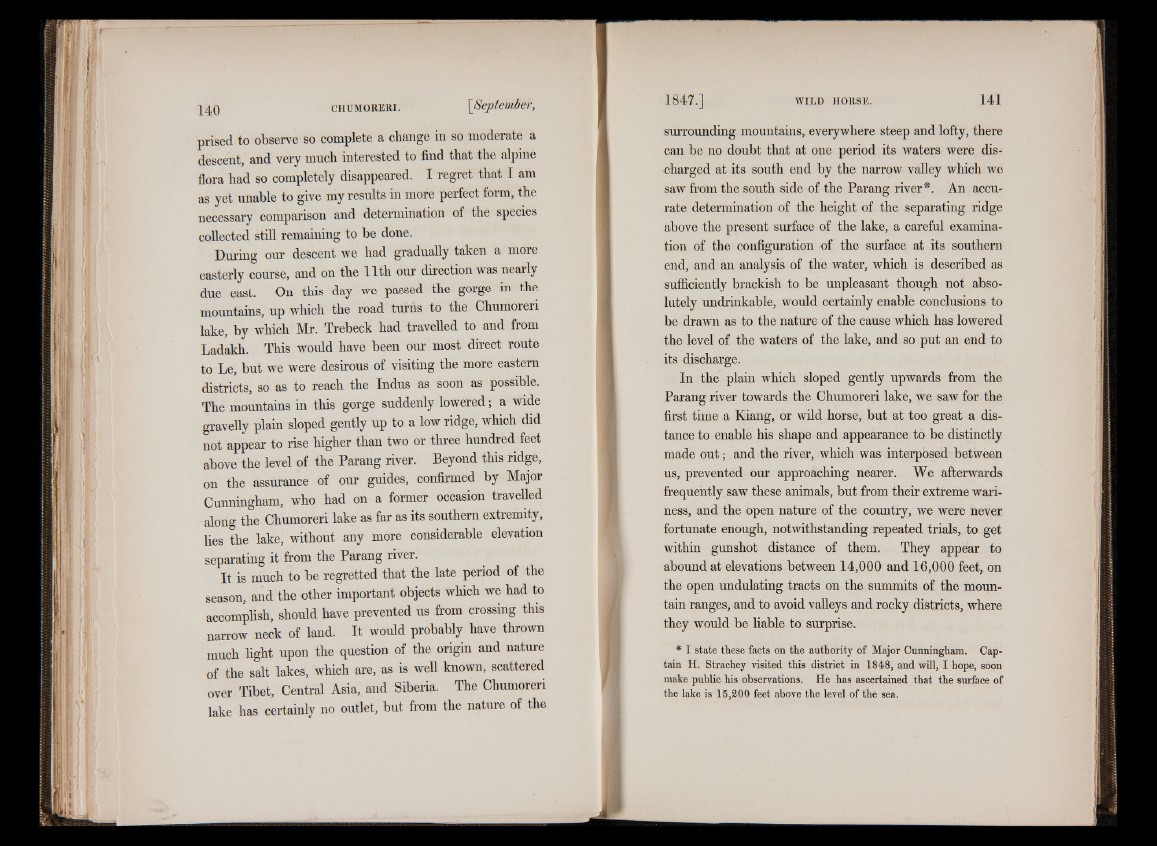
prised to observe so complete a change in so moderate a
descent, and very much interested to find that the alpine
flora had so completely disappeared. I regret that I am
as yet unable to give my results in more perfect form, the
necessary comparison and determination of the species
collected still remaining to be done.
During our descent we had gradually taken a more
easterly course, and on the 11th our direction was nearly
due east. On this day we passed the gorge in the
mountains, up which the road turns to the Chumoreri
lake, by which Mr. Trebeck had travelled to and from
Ladakh. This would have been our most direct route
to Le, but we were desirous of visiting the more eastern
districts, so as to reach the Indus as soon as possible.
The mountains in this gorge suddenly lowered; a wide
gravelly plain sloped gently up to a low ridge, which did
not appear to rise higher than two or three hundred feet
above the level of the Parang river. Beyond this ridge,
on the assurance of our guides, confirmed by Major
Cunningham, who had on a former occasion travelled
along the Chumoreri lake as far as its southern extremity,
lies the lake, without any more considerable elevation
separating it from the Parang river.
It is much to be regretted that the late period of the
season, and the other important objects which we had to
accomplish, should have prevented us from crossing this
narrow neck of land. It would probably have thrown
much fight upon the question of the origin and nature
of the salt lakes, which are, as is well known, scattered
over Tibet, Central Asia, and Siberia. The Chumoreri
lake has certainly no outlet, but from the nature of the
surrounding mountains, everywhere steep and lofty, there
can be no doubt that at one period its waters were discharged
at its south end by the narrow valley which we
saw from the south side of the Parang river*. An accurate
determination of the height of the separating ridge
above the present surface of the lake, a careful examination
of the configuration of the surface at its southern
end, and an analysis of the water, which is described as
sufficiently brackish to be unpleasant though not absolutely
undrinkable, would certainly enable conclusions to
be drawn as to the nature of the cause which has lowered
the level of the waters of the lake, and so put an end to
its discharge.
In the plain which sloped gently upwards from the
Parang river towards the Chumoreri lake, we saw for the
first time a Kiang, or wild horse, but at too great a distance
to enable his shape and appearance to be distinctly
made out; and the river, which was interposed between
us, prevented our approaching nearer. We afterwards
frequently saw these animals, but from their extreme wariness,
and the open nature of the country, we were never
fortunate enough, notwithstanding repeated trials, to get
within gunshot distance of them. They appear to
abound at elevations between 14,000 and 16,000 feet, on
the open undulating tracts on the summits of the mountain
ranges, and to avoid valleys and rocky districts, where
they would be liable to surprise.
* I state these facts on the authority of Major Cunningham. Captain
H. Strachey visited this district in 1848, and will, I hope, soon
make public his observations. He has ascertained that the surface of
the lake is 15,200 feet above the level of the sea.